What are progressive complications? Why do our stories and scenes need them? In this episode, I talk about the people, places, things, and events that stand between your characters and their goals in the context of the opening of Anna Ferguson’s YA science fiction novel, The Empire of Saffron. The editorial mission encourages you to collect progressive complications by reading and watching stories—and thinking about your own life.
As of the day I’m recording this episode, there are 100 days left in 2018, so it’s a great time to think about what you’d like to accomplish with the time that is left this year. In the Writership Podcast community on Slack, I’ve started a channel for accountability, so we can support each other in reaching our writing goals. If you could use some help staying focused on your goals, click here.
Listen to the Writership Podcast
Wise Words on Progressive Complications
“Progressive complications move stories forward, never backward. They do so by making life more and more difficult (in positive as well as negative ways) for your lead character. In other words, you cannot have your protagonist stare down the same dilemma in Act III or Act II that the character already faced in Act I. You must progressively move from one dilemma to a more trying dilemma to a bigger problem to an even bigger problem etc.”
Progressive Complications
Progressive complications are the people, places, things, and events that stand between a character and their goal in stories and scenes. But what purpose do they serve in scenes?
Remember the scene goal that comes from the character’s desire to restore balance after an inciting incident? (See episode 132) If so, then you're well on your way to understanding Progressive Complications. These are the obstacles a character faces as they pursue what they want.
Quick recap: The Inciting Incident upsets the status quo, which causes a desire and then a goal to arise within the mind of the protagonist.
In pursuit of the goal, the protagonist (or POV character in a scene) can encounter four different types of people, places, and things, and events:
obstacles (which appear to be negative),
tools (which appear to be positive), but also
elements within their environment and beyond that seem to be irrelevant to the protagonist’s pursuit, and
unexpected events
The unexpected event is one that arises from the elements that seem irrelevant, but means that the protagonist won’t be able to reach their goal—or at least not in the way they originally intended. This event forces the protagonist or scene POV character into a dilemma (Crisis). When the protagonist decides, and acts on that decision (Climax), consequences unfold (Resolution).
These progressively complicating agents of conflict can be internal (conflict within one’s self, like competing values or desires), interpersonal (conflict with another person or people), or extra-personal (conflict with something the character can’t have a relationship with, like the environment or society). These complications create a gap between what the character expects will happen and the result of their actions. That result changes the character’s circumstances in a particular way, related to universal human needs. (More on that below.)
Things Keep Getting Worse
Within a scene, your point of view character should face several complications. As the scene progresses, these obstacles become more challenging and make it more unlikely the character will reach their goal. This is why we call them progressivecomplications. This is important because if the obstacles get easier, the reader loses interest quickly: no conflict means no tension because we can see how things will work out. (To be clear, sometimes you do want to let up on the tension, but usually not within the series of complications.) Another way to lose the reader's interest is to repeat the same type of complication without intensifying what's at stake for the character.
Key Complications
You’ll need several complications within each unit of story, and the one you’ll want to be especially mindful of (no matter which unit of story you’re working with scene, sequence, act, story): the turning point progressive complication.
The turning point is the unexpected event forces the character into the dilemma that is the Crisis Question I mentioned earlier.
Why is the turning point progressive complication so important? The main reason is that stories are about change: Robert McKee tells us that scenes are “action through conflict … that turns the value-charged condition of a character’s life.” If nothing changes from the beginning to the end of the scene (or any unit of story), it’s merely a series of events, not a scene. Identifying the turning point is the first step in figuring out whether the scene works.
What Does It Mean to Turn Your Scene?
We’re going to take a small detour to get clear about what we mean by turning the scene. Remember the turning point represents an event that sits firmly in the gap between what the character (and reader) expects will happen and what actually happens.
The nature of the change that occurs isn’t random but impacts the specific human need we explore in stories within a genre. I focus on scenes on the podcast, rather than the entire story, but the way a scene turns should impact the way the story turns, that is, the big change that happens over the course of the entire story is driven by the smaller changes that happen within your scenes.
Each genre explores challenges to our human needs and fits within one of the human needs tanks that we get from Maslow’s Hierarchy of Needs. We use tanks that are parallel, instead of Maslow’s triangle, because the pursuit of human needs isn’t a tidy, linear progression, and one tank when full can make up for another tank that’s low in certain circumstances. For example, if you’re really hungry (survival need), the effect of the deficit may be temporarily abated if you’re with someone you love (love and belonging).
Back to Inciting Incidents
Remember from the inciting incidents (episode 132) that each genre has a particular event that kicks the story off? That inciting incident presents a threat or opportunity related to the human need at stake in the genre. You can find genre-specific inciting incidents in the episode 132 show notes.
The progressive complications within the story should affect the specific human need at stake in the genre (e.g., in a worldview maturation or coming of age story, progressive complications make it more and more difficult for the protagonist to hold on to their naïve understanding of life and the world they live in), but others, too.
From the human needs impacted by the inciting incident, we get the Life Value at Stake in the genre, which is the main life value that shifts in the story.
What Is a Life Value Shift?
Life values describe a state or conditions of human life experience. Because stories are about change, we’re interested in life value shifts, in other words when an event or experience changes a state or condition of life. (Click here for a PDF with the genres, life values, and human needs.)
Here's a simple example of a life value shift: Before it rains (event), the grass outside is dry (state). After it rains, the grass is wet. That's a change in the state of the environment that flows from a natural event. The same event could affect the life value for a character and might represent a shift from despair to hope if, for example, the property in question is a farm in a region suffering a prolonged drought.
Here's an example of a change directly related to a character's state: Before eating (event), a person is hungry (state), and after eating, she is full. That's a change in her physiological state. If she had been deprived of food for two weeks, this event could cause her life value to shift from potential death to life.
Here's an example of a value shift in the context of a story scene. Before a man meets a potential love interest (event and experience), he might feel lonely (state), and after the two connect, they are together (at least temporarily) and he might feel companionship. The same scene might be characterized as a change from ignorance (if the two don't know of each other) to attraction (if they like each other). Either way, the event causes a change in the mental or emotional state of the character. Over the course of an entire courtship love story (like Pride and Prejudice), two characters might move from ignorance all the way to commitment.
Your scenes will have a variety of life value changes. Some will be directly or indirectly relevant to the genre’s life value at stake, and some will not. The life values you want to look for when evaluating a scene might be different from but connected to the life value at stake for your genre.
Back to turning points …
Two Types of Turning Points
We have two possibilities when it comes to turning points, but a single turning point could contain both.
Character Action: A character does something that changes circumstances significantly.
Revelation: Information is revealed that changes circumstances significantly.
If you’ve ever heard someone recommend using exposition as ammunition, what they mean is to save backstory and other information the reader needs to know for a moment when it can be used as a revelatory turning point, through conflict, so that it forces the character into a dilemma. It becomes much more meaningful when tied to a pivotal moment than when it is one fact among many delivered in a paragraph about a character or the world.
When filling out the Story Grid spreadsheet, wetrack the turning point as well as its type across the entire story to be sure we’re not using the same type too often. Key tip for innovation: If you think the reader is expecting one, consider using the other.
Turning Points Affect the Reader
Earlier I mentioned that turning points keep the reader turning pages. When they are well executed, they keep the reader engaged with the story and create a satisfying emotional experience. Here’s why:
The reader feels surprise because there is a gap between the character’s expectation and what actually happens.
The reader is curious about why the gap occurred.
The reader reviews information they already know about the characters and events of the story.
The reader gains new insight and a deeper understanding of what has come before.
For example, inThe Empire Strikes Back, there is a revelatory turning point when Darth Vader tells Luke Skywalker who his father is. (The setup for that moment was the beginning of the prior movie.) The revelation is surprising and causes us to review everything we know about Luke’s father. We think about why the information was kept from him. Story events and facts fall into place within a new configuration as we gain a new understanding of what’s at stake for the characters. Mastering these moments in your stories will give you a powerful tool for engaging with your readers.
Our Submission
(Scene Analysis and Editorial Mission follow submission)
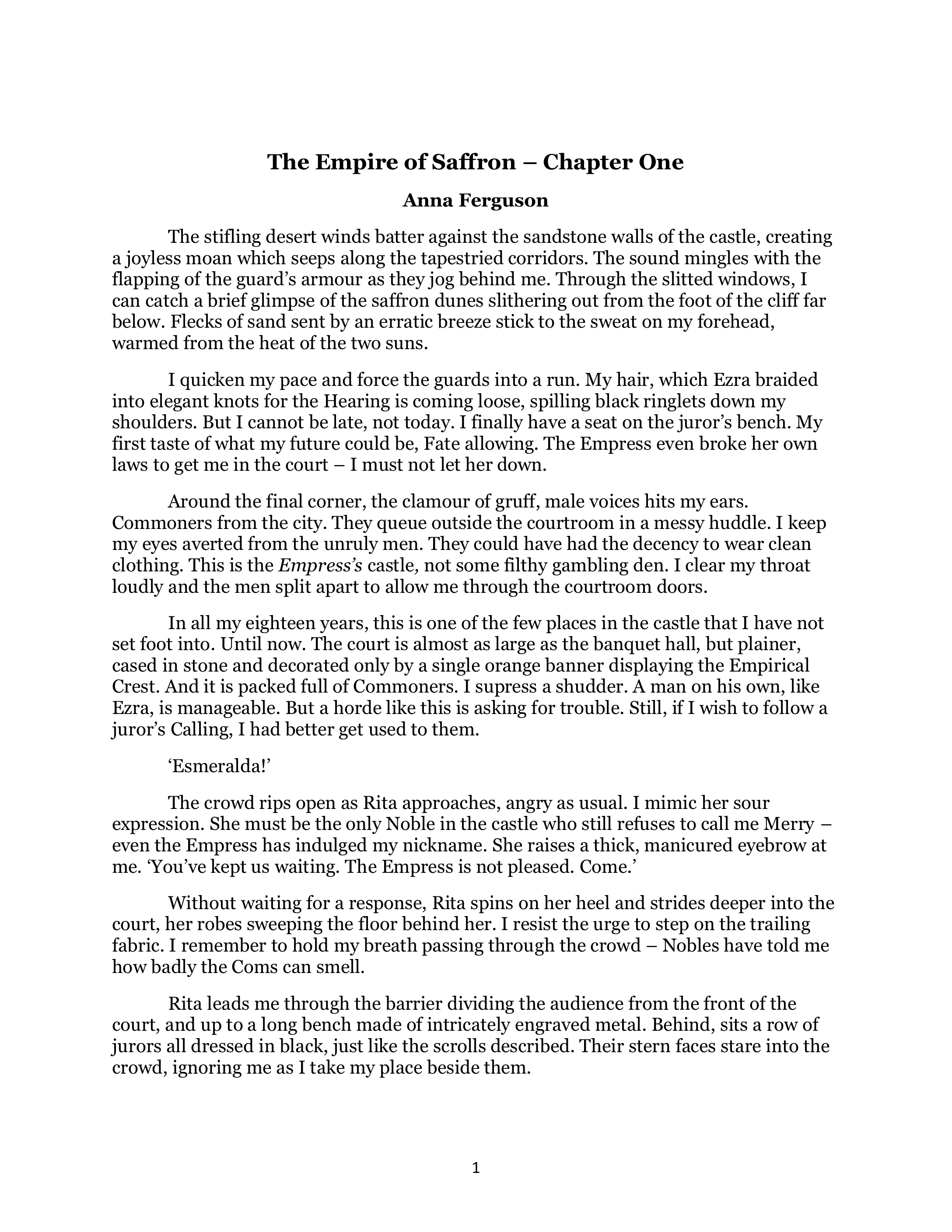
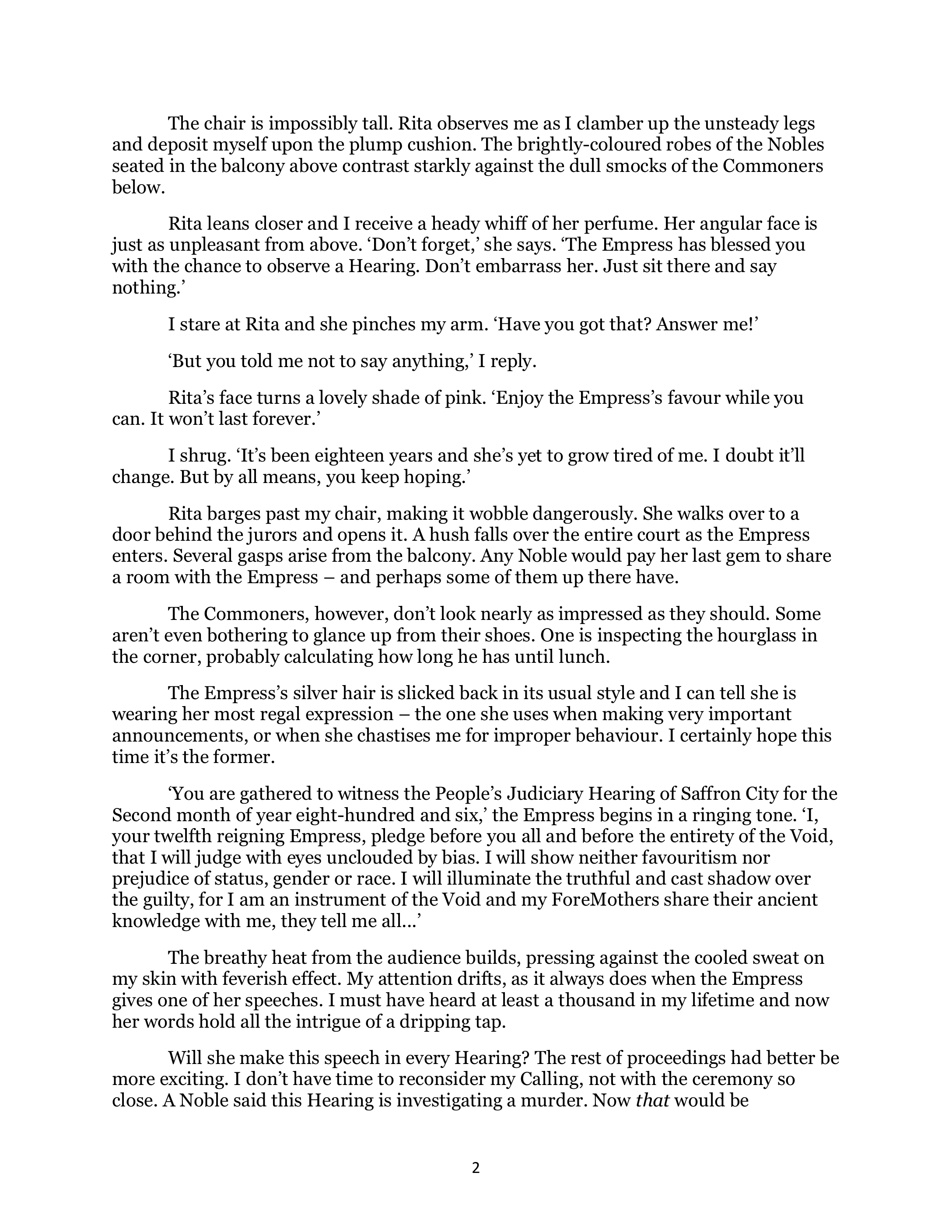
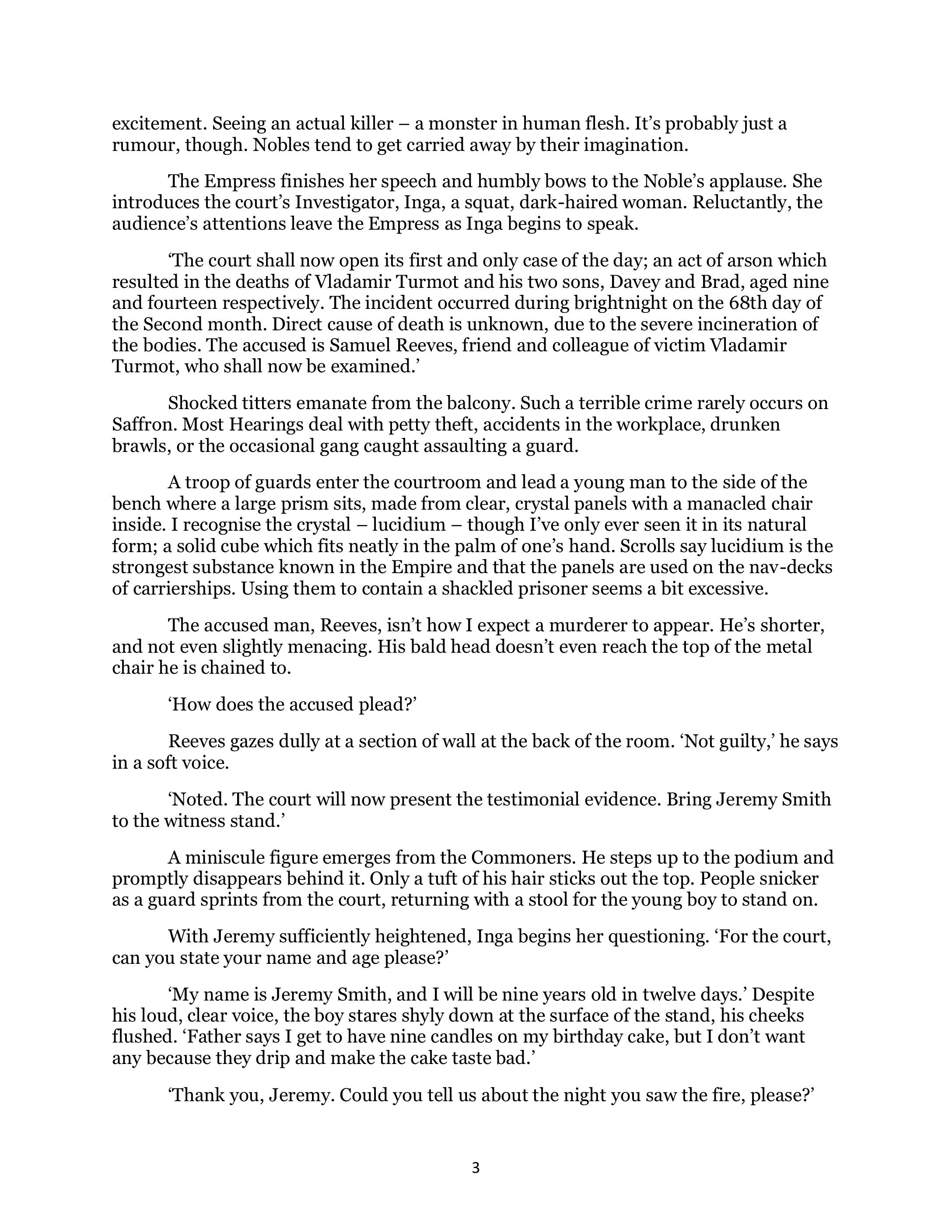
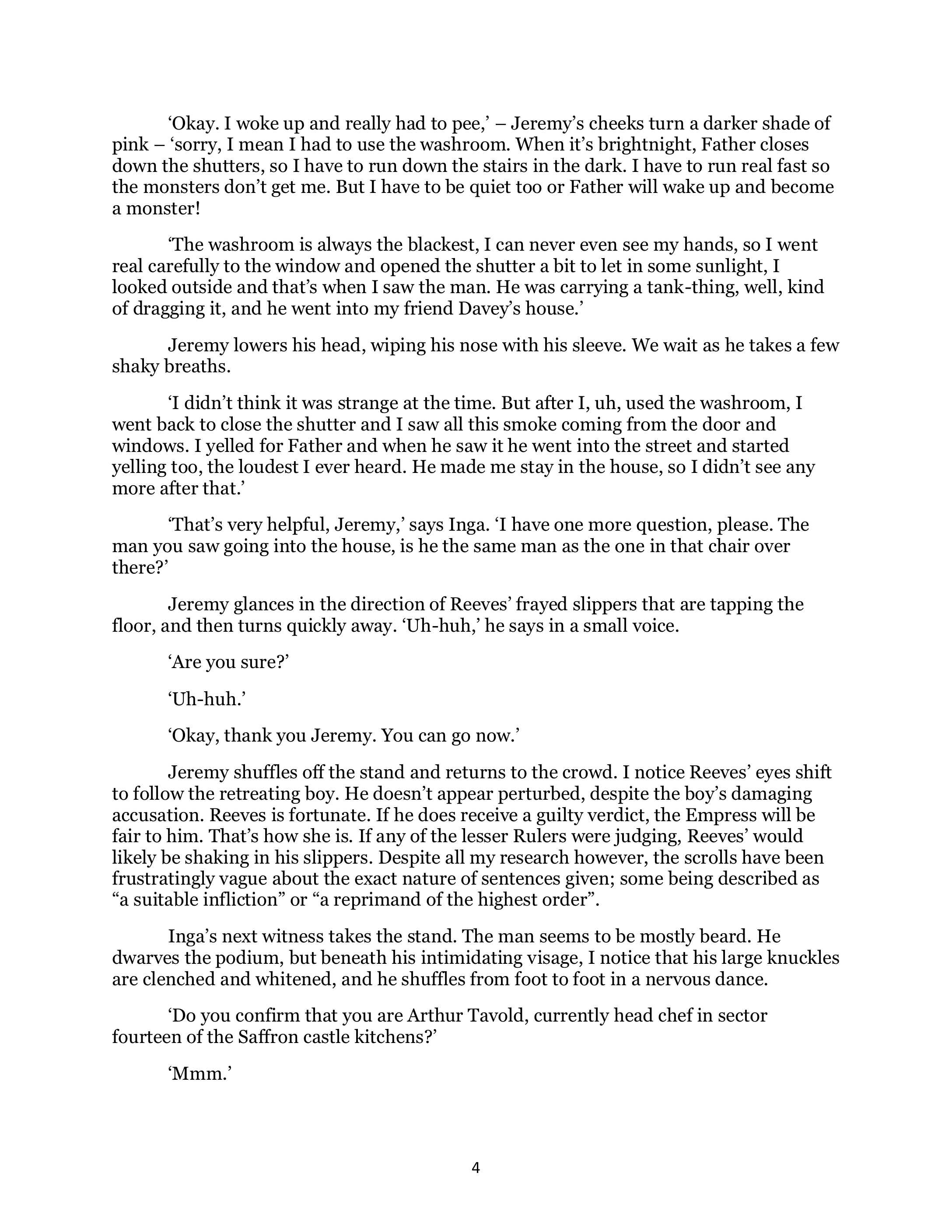
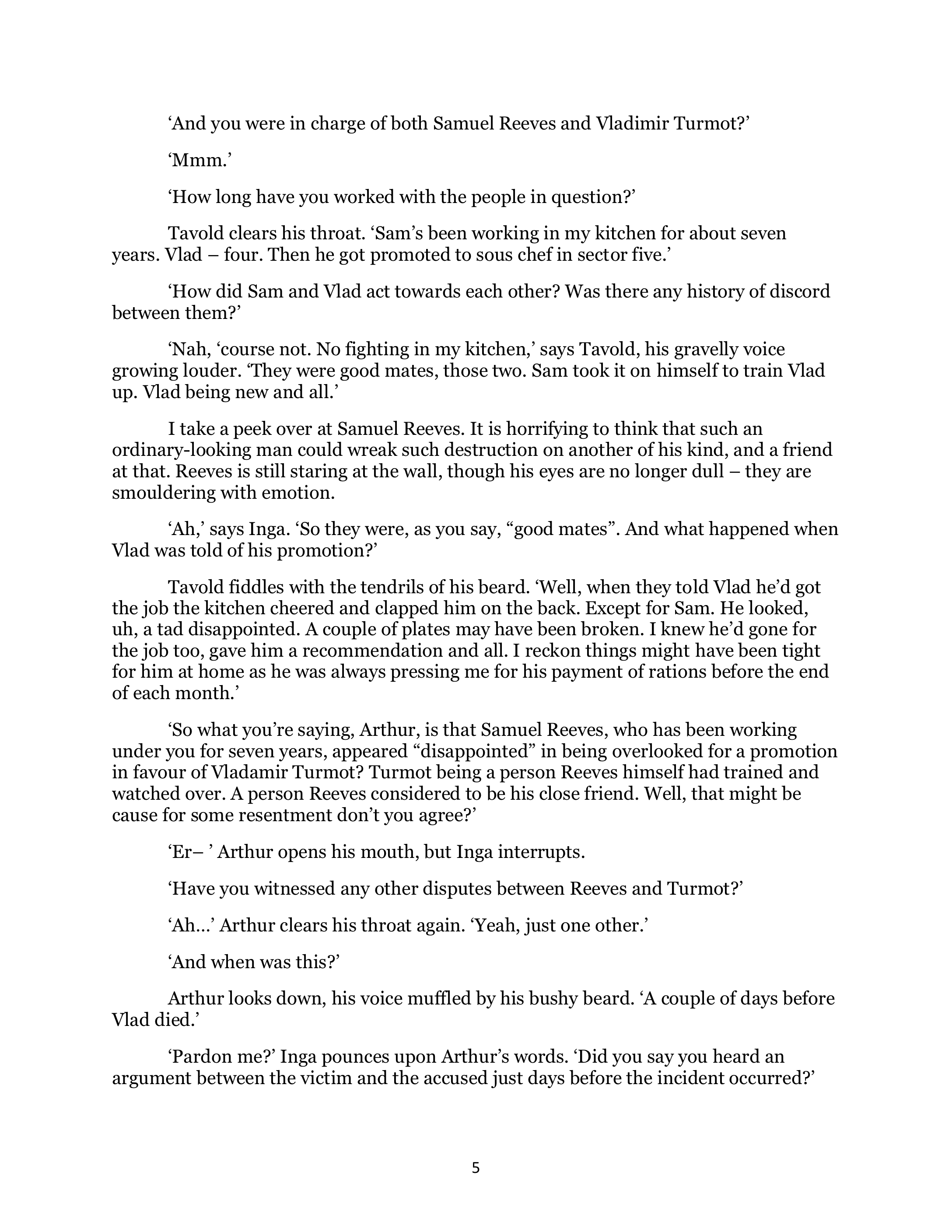
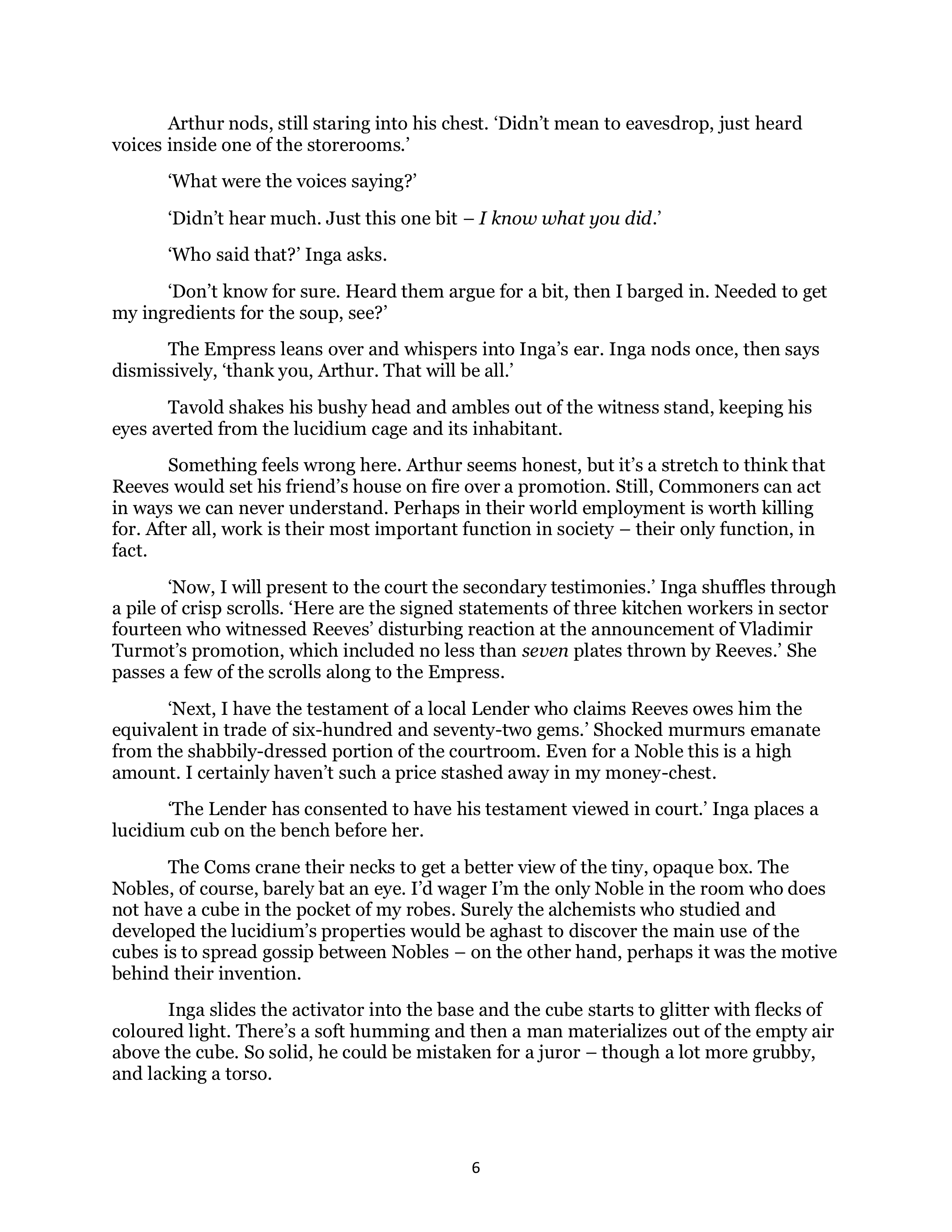
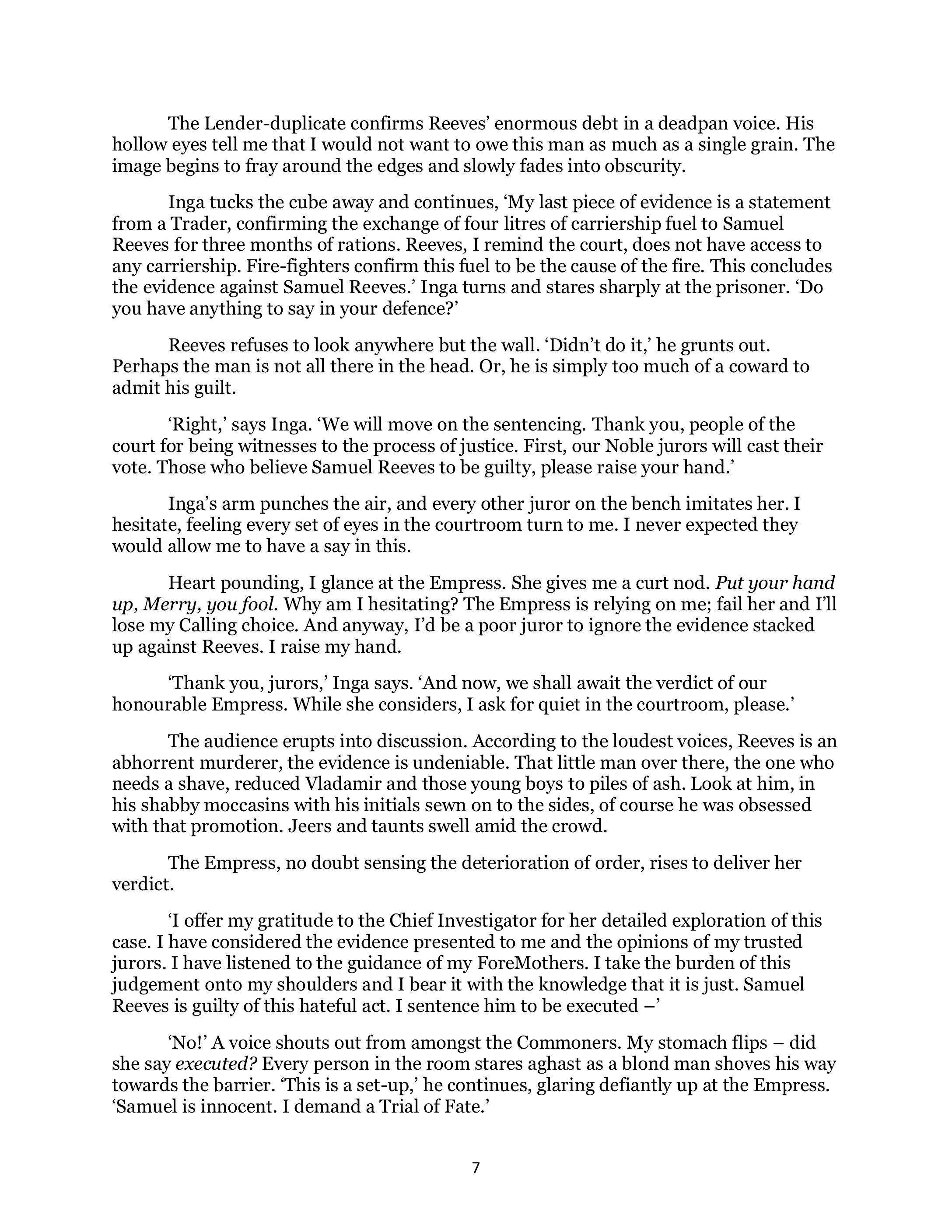
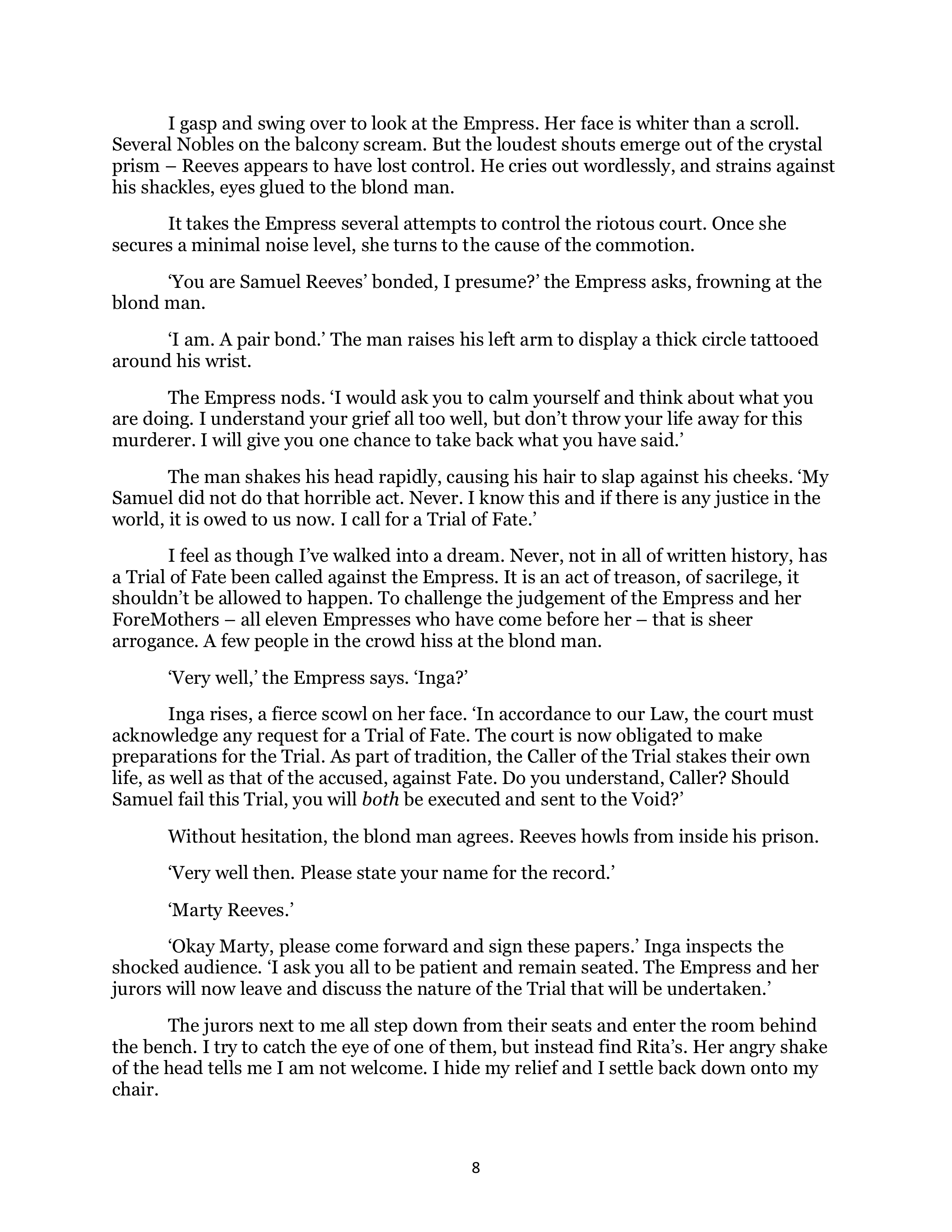

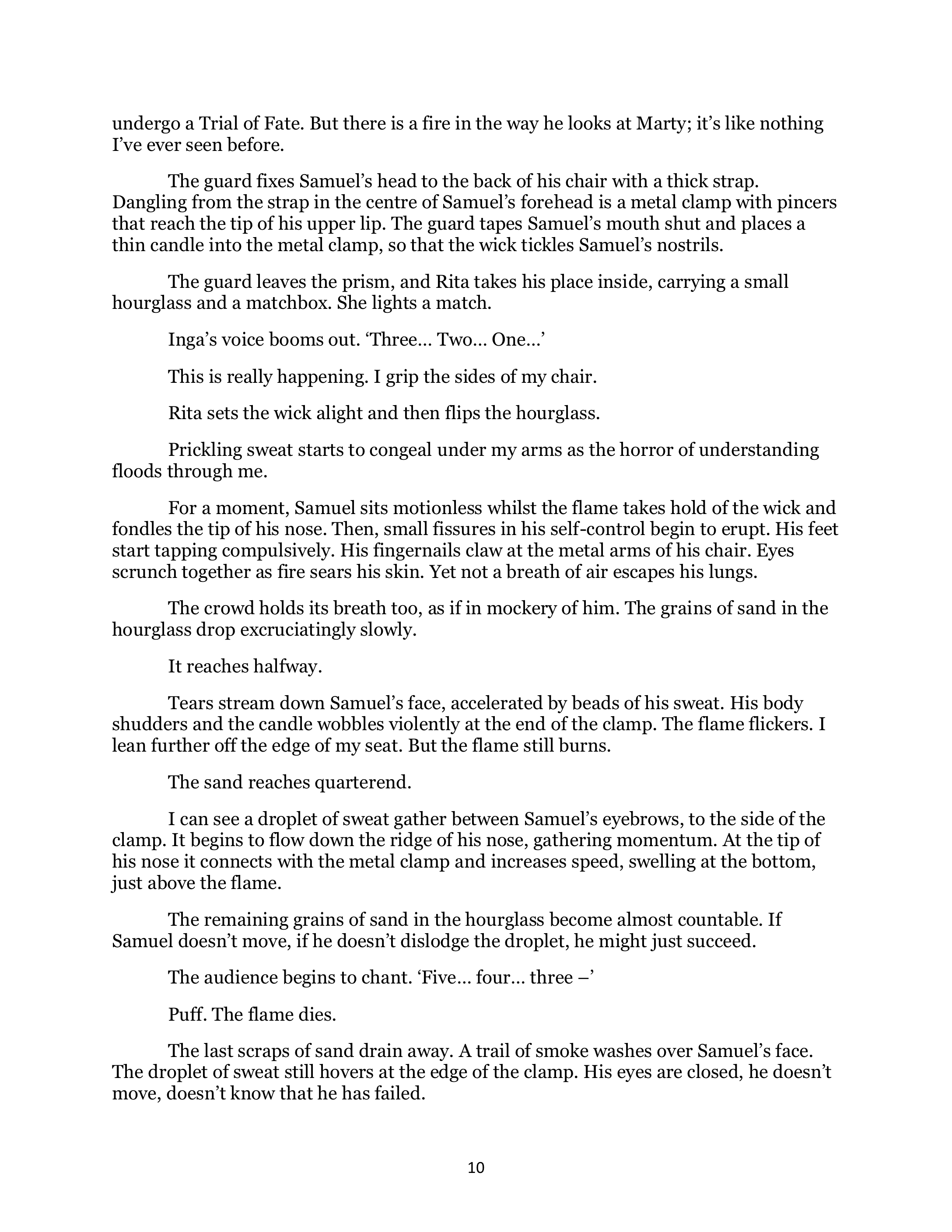
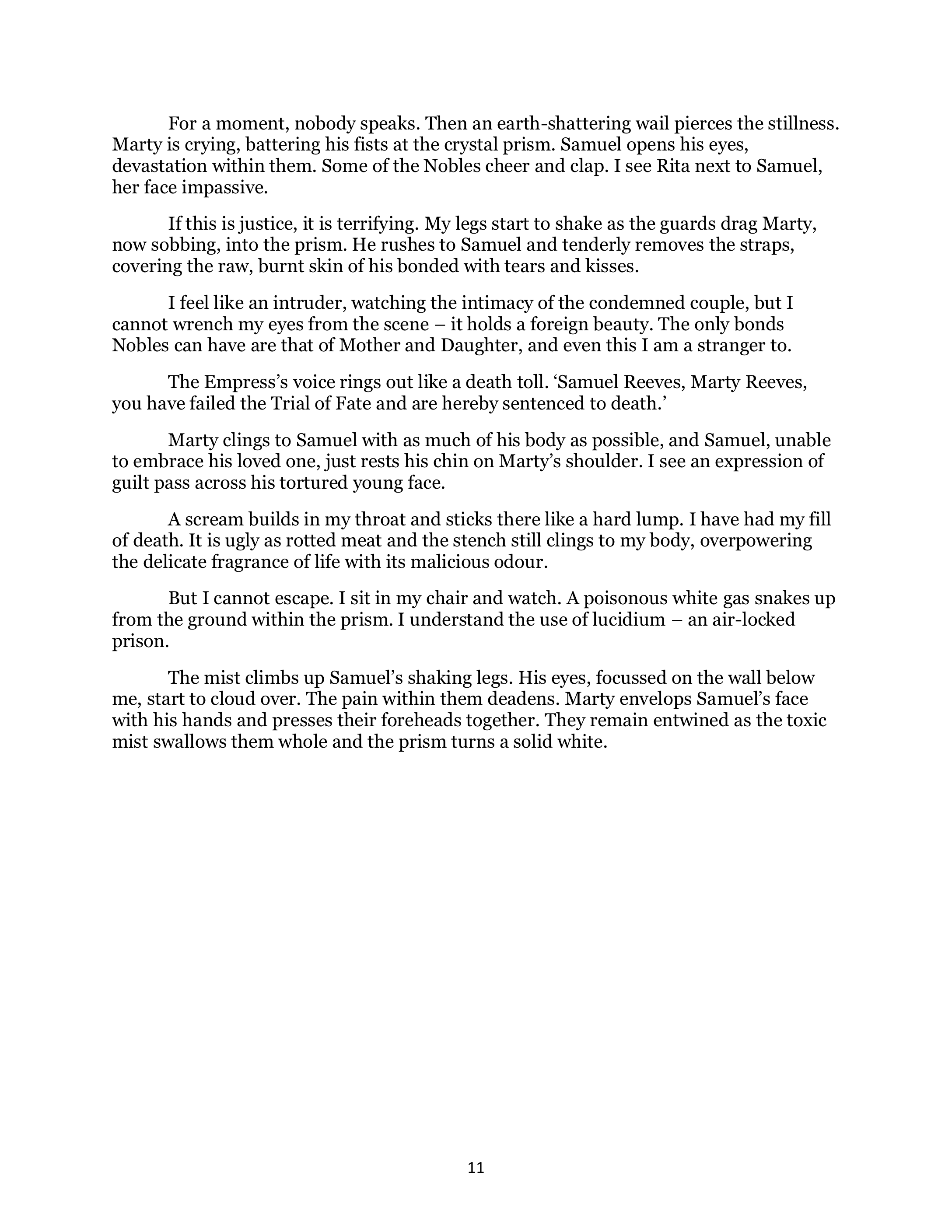
Scene Analysis
Story Event
1. What are the characters literally doing?
Esmeralda is attending her first trial as a juror, what she hopes to be her profession.
2. What is the essence of what the characters are doing?
Generally speaking, Esmeralda doesn't want to disappoint the Empress, but more specifically I think her goal is to show that she’s a good candidate for the position.
3. What life value has changed for one or more characters in the scene?
We could say she goes from inexperienced to initiated, we might also say she goes from being excited and confident to having doubts (about her ability to do the job and about the system) This becomes even more apparent once we move into the sentencing phase of the trial, so be sure to check out the rest of the submission in the show notes).
The defendant goes from guilty to not guilty.
4. Which life value is most relevant to the global genre, the one that would go in a Story Grid spreadsheet?
This always depends on what the overall genre is, but given the way the story begins, I think it’s a safe bet that this is a coming of age or worldview maturation story. The life value at stake is naivete to sophistication. In this case, the shift from confidence to doubt is a likely important change.
Five Commandments
1. What is the inciting incident?
Esmeralda learns that the trial will be a murder case.
2. What are the progressive complications and turning point?
a. The accused doesn’t look like a murderer.
b. Seems unperturbed by the evidence that is mounting against him.
c. The facts and evidence don’t make sense given her view of the world and how people behave.
d. Turning point: The Empress expects her to vote with the other jurors on the guilt of the defendant.
3. What is the crisis?
Guilty or not guilty?
4. What is the climax?
Esmeralda raises her hand to vote in favor of guilt.
5. What is the resolution?
With a unanimous verdict of guilt, the Empress decides the sentence shall be death.
So what does this mean for the scene?
The scene has all the elements of a working scene. It is a fairly complex and has a lot going on, and while the scene . The complications seem related to the scene goal, though there is a little leap in logic required to make the connection, which is fine. Readers don’t like to have everything spelled out for them so long as they can follow what’s happening.
Suggestions for next steps for this submission
My suggestions always depend on whether I’ve read the scene the way the writer intended. If I’ve read it wrong you may want to consider if you’re intention is making it on to the page, but always remember that I’m reading a small portion of your story. No matter who is giving you feedback on your story, you want to consider it, but focus on what you know about your story.
With those caveats, I think Anna might consider adding more of Esmeralda’s reactions to the evidence and particularly what she makes of the verdict (though that personal reflection may be something you want to keep for a later scene). She’s our POV filter for the events, so it’s important for us to see what she makes of the events before her (there are long passages of testimony and it might be useful to share more of her internal reactions). We do see her reactions at pivotal moments, but consider whether the scene reads stronger if we see more of what the events mean to her and what she’s weighing before she makes her decision.
But again, overall, this is a well-executed, working scene.
Editorial Mission—Gather Progressive Complications
As you read or watch stories, identify the obstacles that get in the way of the protagonist’s main story goal and scene goals. Can you identify the level of conflict (internal, interpersonal, or extra-personal)? Begin compiling a list of progressive complications from the stories and scenes you read and watch to use as you plan, draft, and revise scenes for your stories.
In the context of your own life, consider the obstacles you’ve encountered. Look at small and large barriers and the levels of conflict. How did you feel when you faced these challenges? How did you get around them or change your goal?
Keep a list of your personal progressive complications. What are the obstacles that have gotten in the way of small, medium, and audacious goals? Then, as a regular exercise, write about them. Your reactions and emotions can inform what your characters think, say, and do in analogous circumstances.Again, this is what’s really behind the advice to write what you know.
Images courtesy of Anne Hawley, getstencil.com, and Juliana Malta on Unsplash.com

